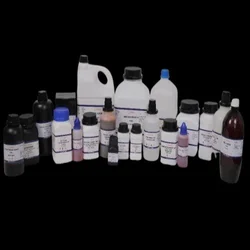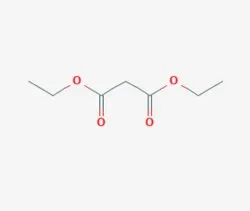Diethyl malonate
Synonym(s):Diethyl malonate;Ethyl malonate, Malonic acid diethyl ester;Malonic acid diethyl ester
- CAS NO.:105-53-3
- Empirical Formula: C7H12O4
- Molecular Weight: 160.17
- MDL number: MFCD00009195
- EINECS: 203-305-9
- SAFETY DATA SHEET (SDS)
- Update Date: 2025-12-22 14:18:24

What is Diethyl malonate?
Description
Diethyl malonate is a diester derivative of malonic acid, a dicarboxylic acid with two carboxyl groups (-COO-) separated by one methylene group (-CH2-). Diethyl malonate is formed by the replacement of the hydroxyl groups (-OH) of malonic acid with ethoxy groups (-OCH2CH3). The hydrogen atoms on the methylene carbon between the two carboxyl groups make this compound acidic. Because of its unique structure, diethyl malonate is reactive and functions as a reagent for organic synthesis and to make products such as barbiturates, pigments, and agrochemicals. Volatile esters are known to have fruity scents and are often used as fragrances and flavorings. Diethyl malonate is a volatile diester that occurs naturally in fruits such as grapes, strawberries, guava, melon, pineapple, and blackberries.
Odor
A colourless liquid with an apple-like odour.
Chemical properties
Diethyl malonate has a faint, pleasant, aromatic odor.
Occurence
Diethyl malonate occurs naturally in grapes and strawberries.
Occurrence
Reported found in pineapple, bilberry, Cape gooseberry, cognac, malt whiskey, apple brandy, grape brandy, port, cider, sherry and red, white, strawberry and bilberry wines.
The Uses of Diethyl malonate
Diethyl Malonate occurs naturally in grapes and strawberries. It is used in the preparation of barbiturates, artificial flavourings, vitamin B1, and vitamin B6 as well as in perfumes.
The Uses of Diethyl malonate
manufacture of barbiturates.
The Uses of Diethyl malonate
Diethyl malonate is used in organic synthesis for the preparation of alpha-aryl malonates, mono-substituted and di-substituted acetic acid, barbiturates and artificial flavorings. It is also involved in the synthesis of pharmaceuticals like chloroquine, butazolidin and barbital. It acts as intermediate in the synthesis of vitamin B1, vitamin B6, non-steroidal anti-inflammatory agents agrochemicals and perfumes. In Knoevenagel condensation reaction, it reacts with benzaldehyde to get diethyl benzylidenemalonate.
Preparation
Reacting chloroacetic acid to cyanoacetic acid using sodium cyanide and subsequent saponification; malonic acid is finally esterified by azeotropic distillation with ethanol in benzene
Definition
ChEBI: Ethyl malonate is a dicarboxylic acid.
Preparation
Diethyl malonate is produced from the reaction of the sodium salt of chloroacetic acid with sodium cyanide, which produces the nitrile. This intermediate is then treated with ethanol in the presence of acid catalyst:
ClCH2CO2Na + NaCN → NCCH2CO2Na + NaCl
Taste threshold values
Taste characteristics at 50 ppm: sweet and fruity with apple and pineapple nuances.
Synthesis Reference(s)
The Journal of Organic Chemistry, 46, p. 3151, 1981 DOI: 10.1021/jo00328a041
Tetrahedron Letters, 36, p. 3997, 1995 DOI: 10.1016/0040-4039(95)00697-B
General Description
Diethyl malonate is diethyl ester of malonic acid. Acylation of diethyl malonate using magnesium chloride and triethylamine is reported. K2CO3-catalyzed 1,4-addition reaction of diethyl malonate with various substituted 1,2-allenic ketones yields polyfunctionalized β,γ-unsaturated enones.
Safety Profile
Mildly toxic by ingestion. A skin irritant. Combustible liquid when exposed to heat or flame; can react with oxidizing materials. To fight fire, use water to blanket fire, foam, CO2, dry chemical. When heated to decomposition it emits acrid smoke and irritating fumes. See also ESTERS.
Metabolism
When the ester was fed to chicks at a level of 5% in the diet, 32% of the energy from diethyl malonate was available (Yoshida et al. 1970). Hydrolysis of diethyl malonate would produce ethanol and malonic acid, which is a relatively strong acid and acts as an inhibitor of enzymes, including succinic dehydrogenase (Fassett, 1963). Malonic acid injected into rats or rabbits is excreted largely unchanged, but also causes increased excretion of citric and a-ketoglutaric acids (Krebs, Salvin & Johnson, 1938). Some malonate may be metabolized through the tricarboxylic acid cycle, with decarboxylation to acetate followed by transformation to succinate, which has been detected in rat urine (Lee & Lifson, 1951). Diethyl malonate was hydrolysed by adipose-tissue lipase (Lynn & Perryman, 1960) and to the monoester by α-chymotrypsin (Cohen & Crossely, 1964). It was oxidized in 110 min to the extent of 34% by the homogenized mycelium of urethane-grown Streptomyces nitrifica (Schatz, Trelawny, Schatz & Mohan, 1957).
Purification Methods
If too impure (IR, NMR) the ester (250g) is heated on a steam bath for 36hours with absolute EtOH (125mL) and conc H2SO4 (75mL), then fractionally distilled under reduced pressure. Otherwise fractionally distil it under reduced pressure and collect the steady boiling middle fraction. [Beilstein 2 IV 1881.]
Properties of Diethyl malonate
| Melting point: | -51--50 °C (lit.) |
| Boiling point: | 199 °C (lit.) |
| Density | 1.055 g/mL at 25 °C (lit.) |
| vapor density | 5.52 (vs air) |
| vapor pressure | 1 mm Hg ( 40 °C) |
| refractive index | n |
| FEMA | 2375 | DIETHYL MALONATE |
| Flash point: | 212 °F |
| storage temp. | Store below +30°C. |
| solubility | 20.8g/l (External MSDS) |
| form | Liquid |
| appearance | Colorless liquid |
| pka | 13.5(at 25℃) |
| color | colourless liquid |
| Odor | Sweet ester odor |
| explosive limit | 0.8-12.8%(V) |
| Water Solubility | Miscible with ethyl alcohol, ether, chloroform and benzene. Slightly miscible with water. |
| JECFA Number | 614 |
| Merck | 14,3823 |
| BRN | 774687 |
| Dielectric constant | 7.9(21℃) |
| Stability: | Stable. Combustible. Incompatible with strong oxidizing agents, |
| CAS DataBase Reference | 105-53-3(CAS DataBase Reference) |
| NIST Chemistry Reference | Propanedioic acid, diethyl ester(105-53-3) |
| EPA Substance Registry System | Diethyl malonate (105-53-3) |
Safety information for Diethyl malonate
| Signal word | Warning |
| Pictogram(s) |
 Exclamation Mark Irritant GHS07 |
| GHS Hazard Statements |
H319:Serious eye damage/eye irritation |
| Precautionary Statement Codes |
P264:Wash hands thoroughly after handling. P264:Wash skin thouroughly after handling. P280:Wear protective gloves/protective clothing/eye protection/face protection. P305+P351+P338:IF IN EYES: Rinse cautiously with water for several minutes. Remove contact lenses, if present and easy to do. Continuerinsing. P337+P313:IF eye irritation persists: Get medical advice/attention. |
Computed Descriptors for Diethyl malonate
| InChIKey | IYXGSMUGOJNHAZ-UHFFFAOYSA-N |
Diethyl malonate manufacturer
JSK Chemicals
Delta Chemsol
New Products
4,4-Difluoropiperidine hydrochloride tert-butyl 9-methoxy-3-azaspiro[5.5]undecane-3-carboxylate Indole Methyl Resin N-Isopropylurea N,N-Dicyclohexylcarbodiimide(DCC) MELDRUMS ACID 5-METHYLISOXAZOLE-4-CARBOXYLIC ACID Magnessium Bis glycinate Zinc ascorbate 1-bromo-2-butyne 2-acetamidophenol 9(10H)-anthracenone Erythrosin B, 4-Piperidinopiperidine 2-((4-morpholinophenylamino) (methylthio) methylene) malononitrile 2,4-dihydroxybenzaldehyde 3-(4-morpholinophenylamino)-5-amino-1H-pyrazole-4-carbonitrile Methyl 2-methylquinoline-6-carboxylate 2,6-dichloro-4-nitropyridine 4-Bromo-2-chlorobenzonitrile 2-(benzylamino)acetic acid hydrochloride 4-(tert-Butoxycarbonylamino)but- 2-ynoic acid 3,4-dihydro-2H-benzo[b][1,4]dioxepine 1-Phenyl-1-cycloprppanecarboxylicacidRelated products of tetrahydrofuran








You may like
-
 Diethyl Malonate 99%View Details
Diethyl Malonate 99%View Details -
 Diethyl Malonate extrapure CAS 105-53-3View Details
Diethyl Malonate extrapure CAS 105-53-3View Details
105-53-3 -
 Diethyl Malonate extrapure AR CAS 105-53-3View Details
Diethyl Malonate extrapure AR CAS 105-53-3View Details
105-53-3 -
 Diethyl Malonate CASView Details
Diethyl Malonate CASView Details -
 Diethyl Malonate CASView Details
Diethyl Malonate CASView Details -
 DI ETHYL MALONATE(105-53-3)View Details
DI ETHYL MALONATE(105-53-3)View Details
105-53-3 -
 Diethyl Malonate ChemicalView Details
Diethyl Malonate ChemicalView Details
105-53-3 -
 Diethyl MalonateView Details
Diethyl MalonateView Details
105-53-3
